Frances Ferguson polled fellow community members on the day rates they charge. Here she shares her findings.
After 18 years as a manager, working in-house and as an L&D consultant in the UK and abroad, setting up my own business is a lot of fun but requires a lot of hard work and research. A key issue to get to grips with is what to charge; what does the market expect and what will it pay?
Reliable day rate information is very difficult to come by and the ongoing economic situation is muddying the waters still further. To gain a better idea of what is happening in the market, I created a very brief questionnaire to ask L&D professionals what their "normal" rates were.
 "The question is, does the 50% more we charge for time spent in the training room simply indicate additional costs or does it show the value our clients place on ensuring the material is right?"
"The question is, does the 50% more we charge for time spent in the training room simply indicate additional costs or does it show the value our clients place on ensuring the material is right?"Requests for replies were placed with key L&D websites. In total, 88 professionals responded, both from consultancies and in-house. I am grateful to every single one of them.
Questions asked
- What is your normal day rate for designing training?
- What is your normal day rate for delivering training?
- What are your core subjects?
- What are the locations of most of your clients?
Reliability of responses
As with any survey, its usefulness is reliant upon the volume and accuracy of the responses. When considering the results of this research, it is good to remember that we are dependent upon the respondents’ interpretation of what constitutes their "normal" day rate.
Anonymity of the respondents has reduced the risk of exaggerated rates but it cannot be discounted. In addition, some L&D professionals will vary their rates depending on how much business they have done, or expect to do, with a client.
Interpreting the responses
The aim of the survey was to help understand:
- Is there a variation in design and delivery rates?
- Does the subject matter influence the day rates?
- Does the location of the business impact day rates?
Respondents were asked to identify their day rates from a list of rate bands and the results are as follows:
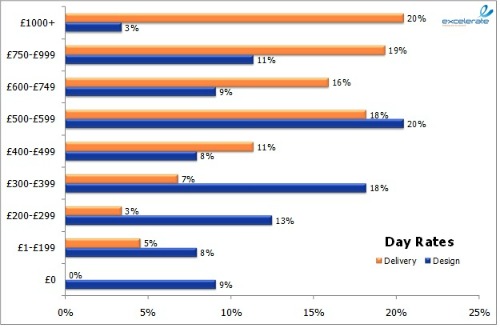
A respondent indicated that their accountant advised that a day rate of less than £610 would make working in-house more financially beneficial; interestingly (of those who replied) 77% charged, or paid, below £600 for design and 45% of them less than this for delivery.
Using the mid point of each day rate range, I was able to identify average day rates.
Of particular interest, was the differential between the average charge for design (£455) and delivery (£720). Only one respondent had higher rates for design than delivery, 34% billed the same for design and delivery. The rest all charged less for design than delivery including 9% who did not charge at all for design.
The question is, does the 50% more we charge for time spent in the training room simply indicate additional costs or does it show the value our clients place on ensuring the material is right?
Subject matter
So what impact did the subject of the training have on the day rates?
Respondents were able to select from a list of subject areas that were non-role or non-industry specific. There were no restrictions upon the number of subjects they could select. On average, 2.4 subjects were chosen, with 36% of respondents having a single core subject area.
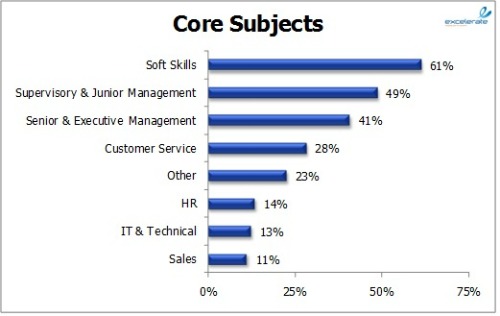
Unsurprisingly, the rates charged appeared to correlate to the seniority of the learner. The interesting anomaly is the rate for HR based training which is normally for the benefit of managers in the business and often requires good legal understanding. It commands an average rate 22% lower than for supervisory/junior management training.
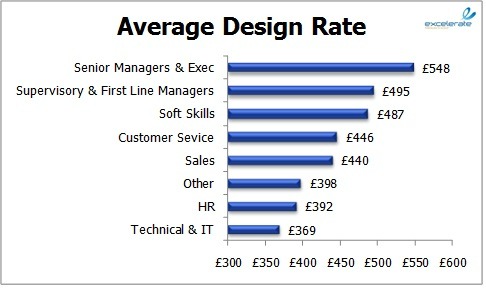
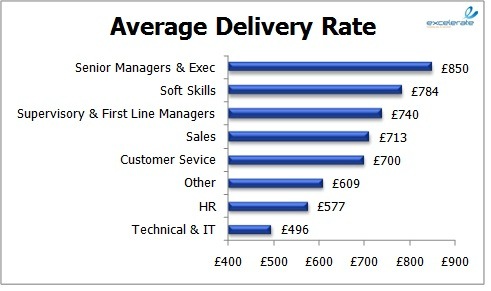
When comparing the difference between design and delivery rates, it is worth considering the subjects with the biggest difference in the design and delivery rates.
Further investigation is needed to understand the reasons behind it; whether this is because for sales, soft skills and customer service the client is less likely to demand bespoke material or is it because a higher premium is charged for delivery where the ability to display the skills in the learning environment is paramount?
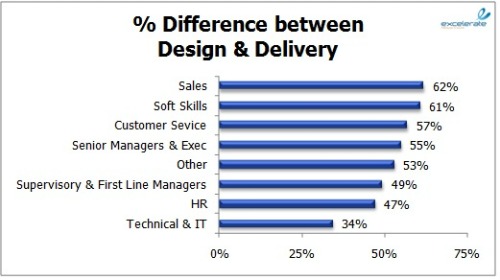
Location
So what impact did the location of the training have on the rates?
Respondents were able to select from a list of locations which were mainly based in UK & Ireland. There were no restrictions upon the number of locations they could select but the question did specify that it was to be a core location. The highest number of locations selected was 11 but on average, 2.1 locations were chosen, with 57% of respondents having a single core location.
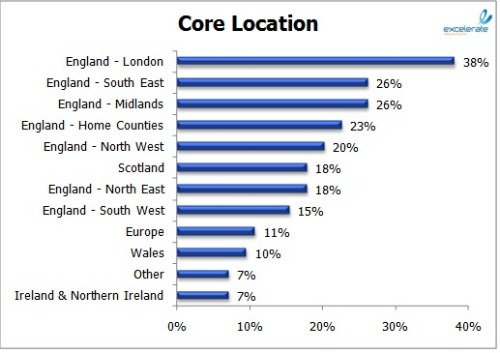
As expected, London and the South East were the two most common responses.
It should be noted (when considering the average day rates) the low numbers of respondents who put their core location as Ireland, Northern Ireland or other.
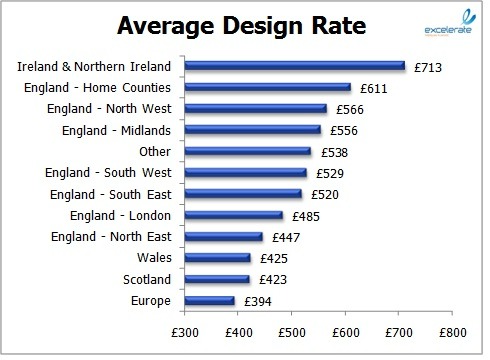
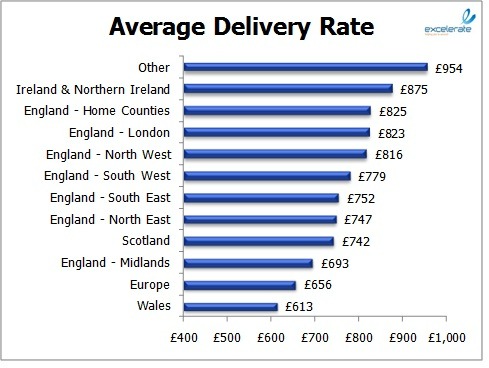
The interesting point to note is the difference in the rates for "Other" – worldwide and Europe. Normally you would expect professionals offered work outside their country of residence to have an expertise that is sufficiently in demand to warrant good rates of pay.
Whilst this seems true of those working further afield, the respondents here show it is not the case in Europe. A further investigation has shown that the core subjects do not have an impact. As such, this anomaly would certainly benefit from further research.
The differences in rates charged for design and delivery rates are very interesting when looked at from a regional perspective as the variations are quite stark.
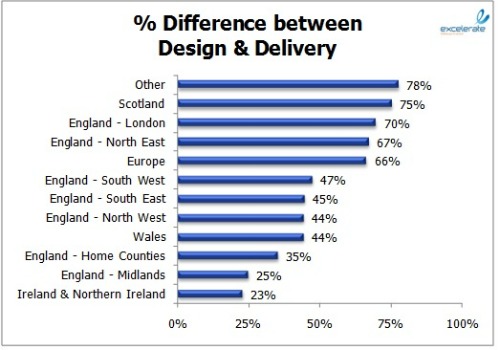
The reality is that the reasons for this result cannot be fully investigated in a simple four question survey. Of all the findings from the survey, this probably warrants the greatest investigation. After all, as any great chef will tell you the secret to success is in the ingredients.
Watch this space as I embark on my next challenge to find out the reasons why . . .
Frances Ferguson has worked as a senior training consultant internationally and has successfully designed and delivered training for companies in the UK, Europe, the Middle East & Australasia. Her speciality is designing highly interactive whole-brain training programs that focus on professional development; challenging the delegates to take specific actions when they return to the work place. Frances can be contacted on Frances@youexcelerate.com.
Frances Ferguson polled fellow community members on the day rates they charge. Here she shares her findings.
After 18 years as a manager, working in-house and as an L&D consultant in the UK and abroad, setting up my own business is a lot of fun but requires a lot of hard work and research. A key issue to get to grips with is what to charge; what does the market expect and what will it pay?
Reliable day rate information is very difficult to come by and the ongoing economic situation is muddying the waters still further. To gain a better idea of what is happening in the market, I created a very brief questionnaire to ask L&D professionals what their "normal" rates were.
 "The question is, does the 50% more we charge for time spent in the training room simply indicate additional costs or does it show the value our clients place on ensuring the material is right?"
"The question is, does the 50% more we charge for time spent in the training room simply indicate additional costs or does it show the value our clients place on ensuring the material is right?"Requests for replies were placed with key L&D websites. In total, 88 professionals responded, both from consultancies and in-house. I am grateful to every single one of them.
Questions asked
- What is your normal day rate for designing training?
- What is your normal day rate for delivering training?
- What are your core subjects?
- What are the locations of most of your clients?
Reliability of responses
As with any survey, its usefulness is reliant upon the volume and accuracy of the responses. When considering the results of this research, it is good to remember that we are dependent upon the respondents’ interpretation of what constitutes their "normal" day rate.
Anonymity of the respondents has reduced the risk of exaggerated rates but it cannot be discounted. In addition, some L&D professionals will vary their rates depending on how much business they have done, or expect to do, with a client.
Interpreting the responses
The aim of the survey was to help understand:
- Is there a variation in design and delivery rates?
- Does the subject matter influence the day rates?
- Does the location of the business impact day rates?
Respondents were asked to identify their day rates from a list of rate bands and the results are as follows:
A respondent indicated that their accountant advised that a day rate of less than £610 would make working in-house more financially beneficial; interestingly (of those who replied) 77% charged, or paid, below £600 for design and 45% of them less than this for delivery.
Using the mid point of each day rate range, I was able to identify average day rates.
Of particular interest, was the differential between the average charge for design (£455) and delivery (£720). Only one respondent had higher rates for design than delivery, 34% billed the same for design and delivery. The rest all charged less for design than delivery including 9% who did not charge at all for design.
The question is, does the 50% more we charge for time spent in the training room simply indicate additional costs or does it show the value our clients place on ensuring the material is right?
Subject matter
So what impact did the subject of the training have on the day rates?
Respondents were able to select from a list of subject areas that were non-role or non-industry specific. There were no restrictions upon the number of subjects they could select. On average, 2.4 subjects were chosen, with 36% of respondents having a single core subject area.
Unsurprisingly, the rates charged appeared to correlate to the seniority of the learner. The interesting anomaly is the rate for HR based training which is normally for the benefit of managers in the business and often requires good legal understanding. It commands an average rate 22% lower than for supervisory/junior management training. 

When comparing the difference between design and delivery rates, it is worth considering the subjects with the biggest difference in the design and delivery rates.
Further investigation is needed to understand the reasons behind it; whether this is because for sales, soft skills and customer service the client is less likely to demand bespoke material or is it because a higher premium is charged for delivery where the ability to display the skills in the learning environment is paramount?
Location
So what impact did the location of the training have on the rates?
Respondents were able to select from a list of locations which were mainly based in UK & Ireland. There were no restrictions upon the number of locations they could select but the question did specify that it was to be a core location. The highest number of locations selected was 11 but on average, 2.1 locations were chosen, with 57% of respondents having a single core location. 
As expected, London and the South East were the two most common responses.
It should be noted (when considering the average day rates) the low numbers of respondents who put their core location as Ireland, Northern Ireland or other. 

The interesting point to note is the difference in the rates for "Other" - worldwide and Europe. Normally you would expect professionals offered work outside their country of residence to have an expertise that is sufficiently in demand to warrant good rates of pay.
Whilst this seems true of those working further afield, the respondents here show it is not the case in Europe. A further investigation has shown that the core subjects do not have an impact. As such, this anomaly would certainly benefit from further research.
The differences in rates charged for design and delivery rates are very interesting when looked at from a regional perspective as the variations are quite stark.
The reality is that the reasons for this result cannot be fully investigated in a simple four question survey. Of all the findings from the survey, this probably warrants the greatest investigation. After all, as any great chef will tell you the secret to success is in the ingredients.
Watch this space as I embark on my next challenge to find out the reasons why . . .
Frances Ferguson has worked as a senior training consultant internationally and has successfully designed and delivered training for companies in the UK, Europe, the Middle East & Australasia. Her speciality is designing highly interactive whole-brain training programs that focus on professional development; challenging the delegates to take specific actions when they return to the work place. Frances can be contacted on Frances@youexcelerate.com.






One Response
We are delivering a 3-year
We are delivering a 3-year European funded project for which we are paid according to intellectual outputs, the project manager has suggested I do a further piece of work on developing a manual (with instruments) so I am going to hit him with (a) the fact that this is not included in my budget and (b) how long it will take and (c) what the actual cost would be. Time to get back to daily rates I think, especially with Brexit to consider and the uncertainty arising from the next 2 years.